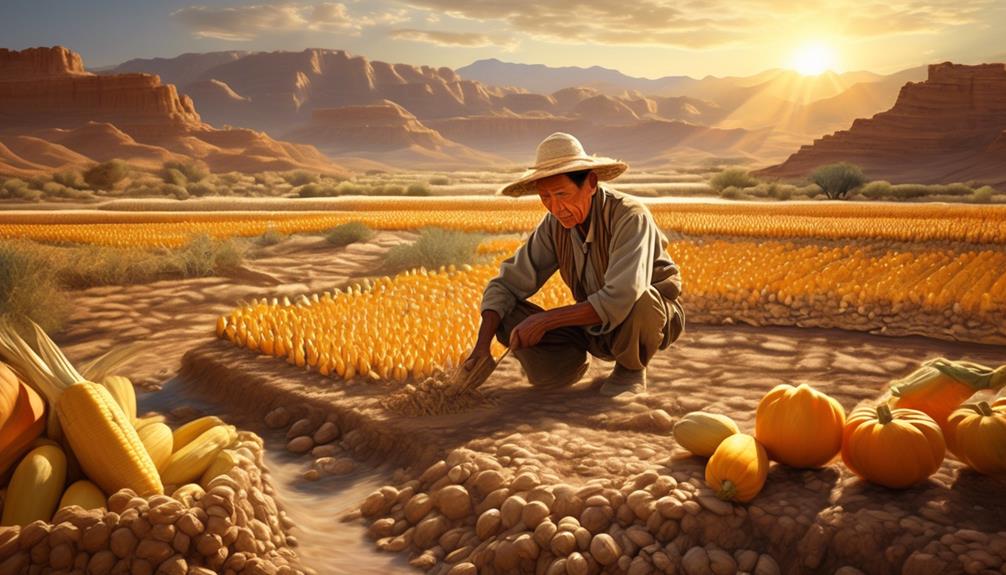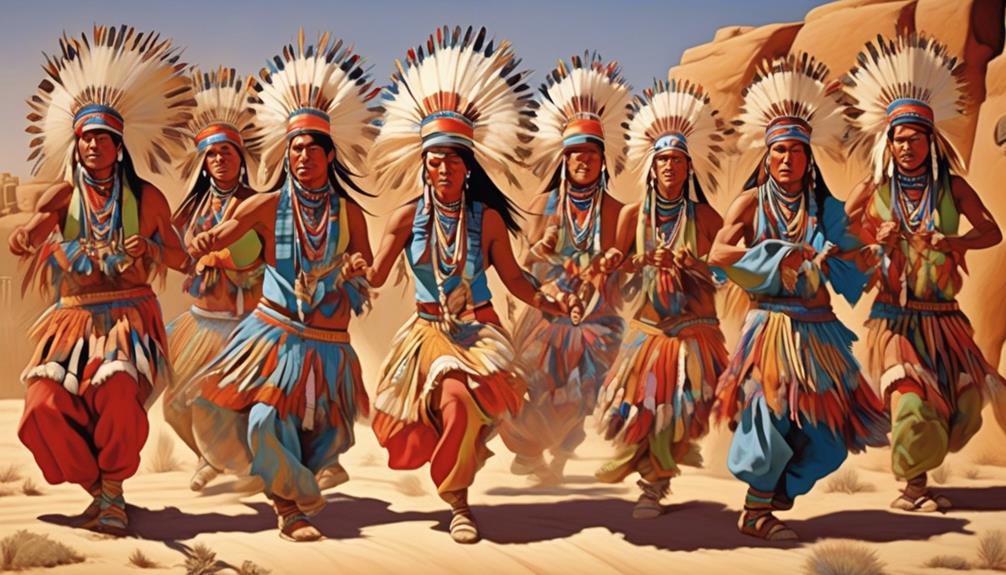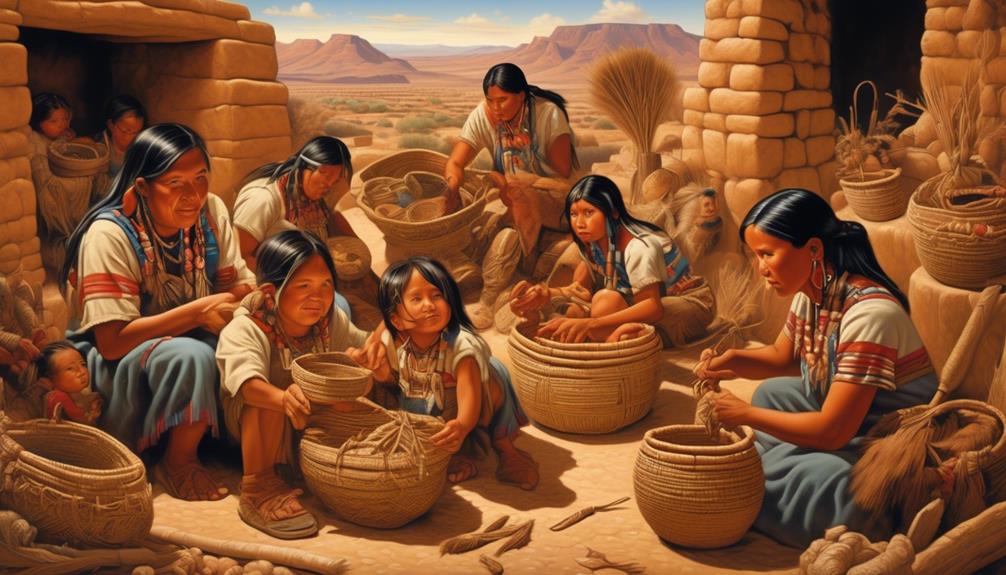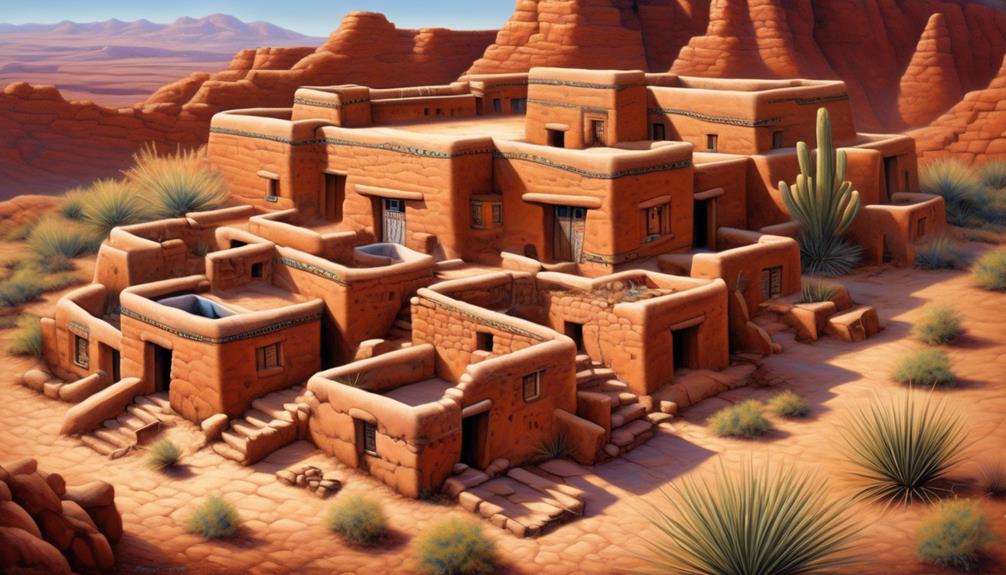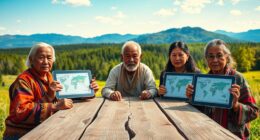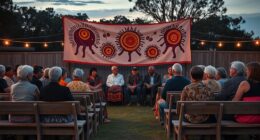When examining the dietary patterns of the Hopi tribe, one might initially think that their isolated desert surroundings made it difficult to access food. Nonetheless, their ingenuity and innovation enabled them to create advanced agricultural methods that provided sustenance for their community over many generations.
From cultivating staple crops to incorporating hunting and gathering into their food procurement methods, the Hopi tribe's approach to securing sustenance was both practical and culturally significant.
As we explore the intricacies of how the Hopi tribe obtained their food, we will uncover a rich tapestry of traditions and practices that not only sustained their bodies but also played a vital role in shaping their identity and way of life.
Key Takeaways
- Hopi developed sophisticated agricultural techniques in the desert, such as constructing 'waffle gardens' and practicing sustainable agriculture.
- Cultivating staple crops like corn, beans, and squash is integral to Hopi's sustainable agriculture, and they use crop rotation and terraced fields for efficient irrigation.
- Hunting and gathering sustain Hopi with diverse wild foods, and knowledge of these practices is passed down through oral tradition.
- Trade and exchange played a significant role in Hopi's interconnectedness, facilitating cultural exchange and access to scarce resources.
Agricultural Techniques
The Hopi people have cultivated and perfected their agricultural techniques for generations, enabling them to sustainably produce food in the arid environment of the American Southwest. Their irrigation methods are particularly noteworthy, as they ingeniously capture and conserve scarce water resources. The Hopi have constructed a system of earthen irrigation channels, known as 'waffle gardens,' which efficiently direct water to the crops while minimizing evaporation. This ancient technique demonstrates the Hopi's deep understanding of hydrology and their ability to adapt to challenging environmental conditions.
Furthermore, the Hopi have traditionally practiced sustainable agriculture by carefully managing soil fertility. They use organic materials such as manure, ash, and compost to enrich the soil and maintain its productivity. By rotating their crops and allowing fields to fallow, the Hopi prevent soil depletion and erosion, ensuring the long-term viability of their agricultural lands. These methods not only sustain the fertility of the soil but also reflect the profound cultural connection the Hopi have with the land.
The Hopi's agricultural techniques are a testament to their ingenuity and resourcefulness, allowing them to thrive in a harsh desert environment while preserving their cultural heritage.
Staple Crops
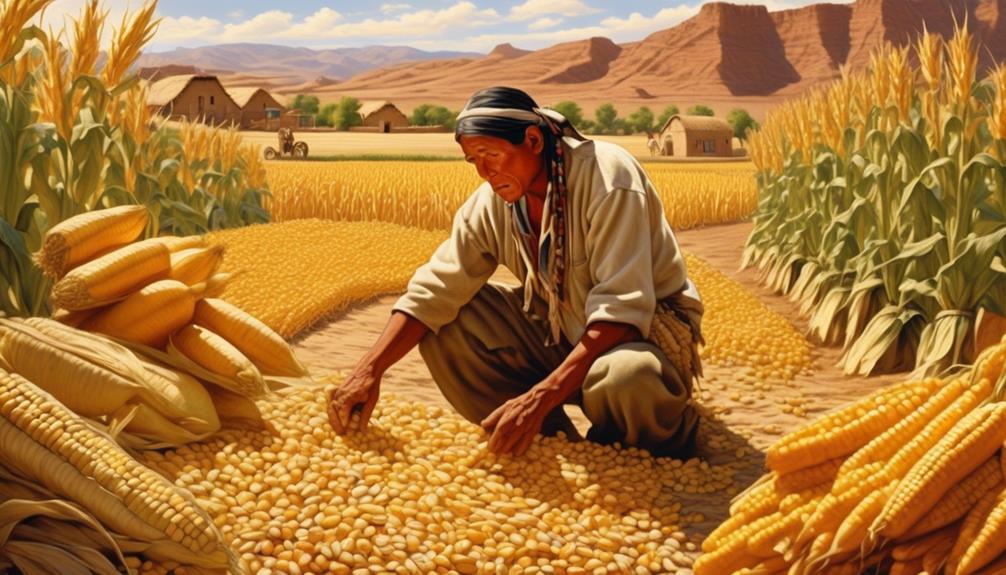
Cultivating a variety of staple crops has been an integral part of our sustainable agricultural practices, allowing us to maintain our rich cultural heritage while adapting to the arid environment of the American Southwest. Our staple crops, including corn, beans, and squash, form the cornerstone of our traditional diet and are deeply intertwined with our cultural identity.
To sustainably manage our crops, we employ crop rotation, a method that not only preserves soil fertility but also aligns with our spiritual beliefs, emphasizing harmony and balance with nature. This practice involves alternating the types of crops grown in specific fields each season, ensuring that the soil remains nutrient-rich and productive.
Furthermore, our irrigation methods reflect our deep understanding of the arid environment. Utilizing a system of terraced fields and hand-dug irrigation ditches known as 'waffle gardens,' we efficiently capture and distribute scarce water resources. The careful management of water resources not only supports the growth of our staple crops but also underscores our commitment to sustainable agricultural practices that have been passed down through generations.
Our agricultural techniques and the cultivation of staple crops aren't just about sustenance; they represent a profound cultural connection to the land and the rhythms of nature.
Hunting and Gathering
Deeply connected to the land, our hunting and gathering practices reflect our tribe's enduring relationship with the natural world, sustaining us with a diverse array of wild foods and resources. Our hunting techniques have been honed over generations, ensuring the ethical and sustainable procurement of meat. We employ various methods, such as using bows and arrows, snares, and traps. Each technique is deeply rooted in tradition and respect for the animals we hunt. Additionally, foraging methods are integral to our sustenance. We venture into the wilderness, guided by a profound understanding of the land and its resources. Our foraging techniques involve identifying edible plants, fruits, and roots, recognizing their seasonal availability and locations. This knowledge has been passed down through oral tradition, ensuring the preservation of our cultural heritage. To provide a more comprehensive understanding, the table below highlights some of the key hunting and foraging practices of the Hopi Tribe.
| Hunting Techniques | Foraging Methods | Ethical Procurement | Sustainable Foraging |
|---|---|---|---|
| Bows and Arrows | Edible Plant ID | Respectful Harvest | Seasonal Awareness |
| Snares | Fruit Recognition | Tradition-rooted | Land Preservation |
| Traps | Root Gathering | Cultural Heritage | Oral Tradition |
Trade and Exchange
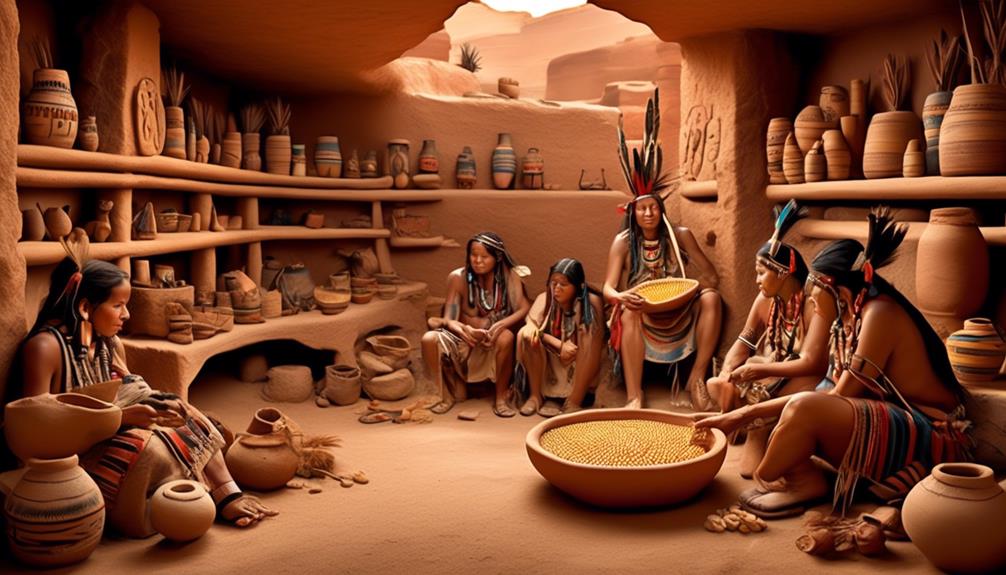
Rooted in our cultural traditions, trade and exchange have long been integral to the interconnectedness of the Hopi Tribe with neighboring communities. The barter system was a common practice, and it played a significant role in our economic relationships with other tribes. Through trade, we exchanged surplus crops, such as corn, beans, and squash, for goods like pottery, jewelry, and animal hides.
This fostered not only economic ties but also cultural exchange, as we shared traditions and knowledge with other tribes. Additionally, trade allowed us to acquire resources that were scarce in our region, such as seashells and salt, which were highly valued commodities. This intertribal trade network was essential for the well-being of our community, as it ensured access to essential resources and facilitated the exchange of specialized craftsmanship.
Furthermore, it strengthened our bonds with neighboring tribes, creating a network of mutual support and cooperation that enriched our cultural heritage. The barter system and economic relationships formed through trade were foundational to the sustainability and prosperity of the Hopi Tribe.
Cultural Significance
Our interconnectedness with neighboring communities through trade and exchange has deeply impacted the cultural significance of our traditions and heritage within the Hopi Tribe.
The ways in which we acquire our food are deeply intertwined with our spiritual rituals and community gatherings, forming the very essence of our cultural identity.
The act of obtaining food isn't merely a means of sustenance for the Hopi Tribe; it's a sacred practice that's woven into the fabric of our existence.
Our spiritual rituals, such as the planting ceremonies and harvest dances, are intricately connected to the cultivation and gathering of food. These rituals not only ensure a bountiful harvest but also serve as a way to express gratitude to the earth and the spirits that bless us with sustenance.
Furthermore, the sharing of food holds a profound significance in our community. Community gatherings centered around food create opportunities for bonding, storytelling, and the passing down of traditions from one generation to the next.
The act of sharing food is a symbol of unity and interconnectedness, reinforcing the importance of collective harmony within the tribe.
Our cultural significance is deeply rooted in the ways we procure, share, and celebrate our food, making it an integral part of our identity as the Hopi Tribe.
Frequently Asked Questions
What Role Did Spirituality and Religious Ceremonies Play in the Hopi Tribe's Food Procurement?
Spiritual ceremonies were central to the Hopi tribe's food procurement. Through rituals and prayers, we sought the guidance of deities for successful harvests.
Our deep spiritual connection to the land influenced our agricultural practices, allowing us to adapt to the arid environment and cultivate crops like corn, beans, and squash.
Traditional cooking methods preserved the cultural significance of our food, reflecting our reverence for the earth and the nourishment it provided.
How Did the Hopi Tribe Adapt Their Food Sources to Different Environmental Conditions?
Adapting to different environmental conditions was crucial for the Hopi tribe. They utilized traditional cooking methods and surplus food preservation techniques to ensure food security.
What Were the Traditional Cooking Methods Used by the Hopi Tribe for Preparing Their Food?
Traditional cooking methods and food preparation techniques of the Hopi Tribe were deeply ingrained in their cultural practices. They utilized various methods such as baking, boiling, and roasting to prepare their food.
The tribe's cooking techniques were closely tied to their agricultural practices and the resources available in their environment. These methods weren't only practical but also held significant cultural and spiritual significance for the Hopi people.
How Did the Hopi Tribe Preserve and Store Their Surplus Food for Future Use?
We grappled with the challenge of food preservation, employing ingenious storage techniques to manage our surplus.
Sustainability practices were at the core of our surplus food management. Our cultural methods of food preservation reflected our deep understanding of the land and its resources.
Through these practices, we ensured that our food remained viable for consumption, sustaining our community through times of scarcity.
What Impact Did Colonization and Assimilation Have on the Hopi Tribe's Traditional Food Practices?
Colonization and assimilation had a significant impact on the Hopi Tribe's traditional food practices. These practices were deeply rooted in their cultural identity, but the arrival of colonizers brought about disruptions to their food systems.
Forced assimilation led to the loss of traditional farming and hunting grounds, affecting their ability to access and maintain their traditional food sources.
These disruptions had a lasting impact on the Hopi Tribe's food sovereignty and cultural practices.
Conclusion
In conclusion, the Hopi tribe relied on a combination of agricultural techniques, hunting and gathering, and trade to secure their food supply.
One interesting statistic is that the Hopi people were known for their skill in dry farming, which allowed them to grow crops like corn, beans, and squash in the arid desert environment of the American Southwest. This unique ability to cultivate food in challenging conditions is a testament to the resilience and resourcefulness of the Hopi people.
